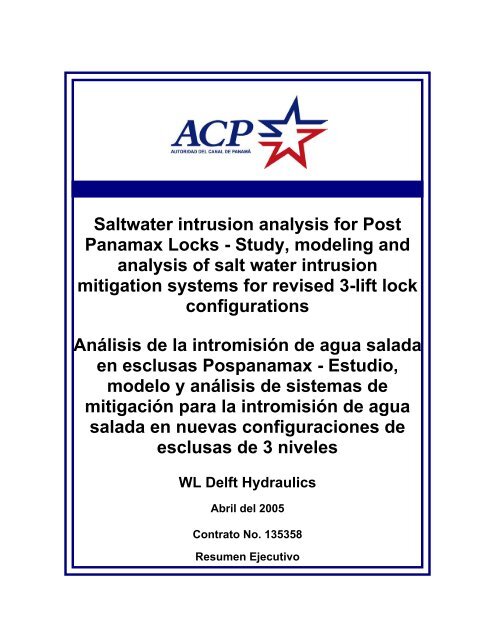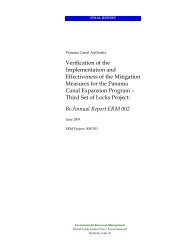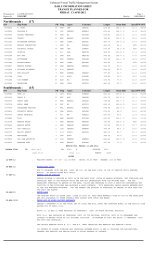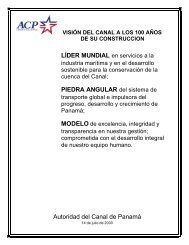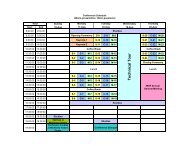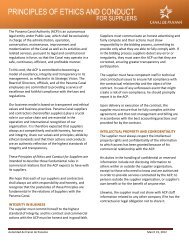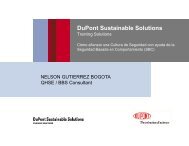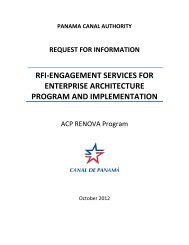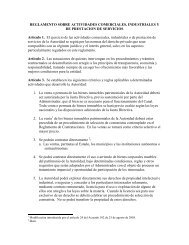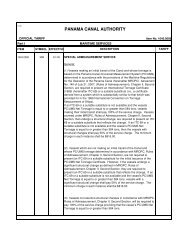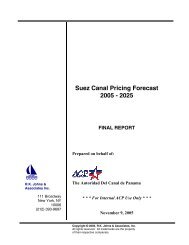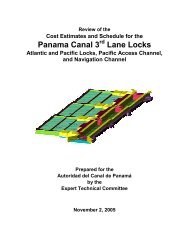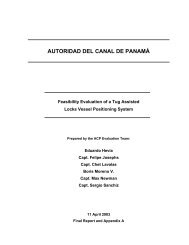Salt water intrusion - Canal de Panamá
Salt water intrusion - Canal de Panamá
Salt water intrusion - Canal de Panamá
You also want an ePaper? Increase the reach of your titles
YUMPU automatically turns print PDFs into web optimized ePapers that Google loves.
<strong>Salt</strong><strong>water</strong> <strong>intrusion</strong> analysis for Post<br />
Panamax Locks - Study, mo<strong>de</strong>ling and<br />
analysis of salt <strong>water</strong> <strong>intrusion</strong><br />
mitigation systems for revised 3-lift lock<br />
configurations<br />
Análisis <strong>de</strong> la intromisión <strong>de</strong> agua salada<br />
en esclusas Pospanamax - Estudio,<br />
mo<strong>de</strong>lo y análisis <strong>de</strong> sistemas <strong>de</strong><br />
mitigación para la intromisión <strong>de</strong> agua<br />
salada en nuevas configuraciones <strong>de</strong><br />
esclusas <strong>de</strong> 3 niveles<br />
WL Delft Hydraulics<br />
Abril <strong>de</strong>l 2005<br />
Contrato No. 135358<br />
Resumen Ejecutivo
<strong>Salt</strong> Water Intrusion Analysis Panama <strong>Canal</strong> Locks <strong>Salt</strong> Water Intrusion Mitigation Systems - Report F - SummaryQ3696, April 2005<br />
<strong>Salt</strong> Water Intrusion Analysis<br />
Panama <strong>Canal</strong> Locks<br />
Future situation: Post-Panamax Locks<br />
Report F<br />
Study, mo<strong>de</strong>ling and analysis of<br />
salt <strong>water</strong> <strong>intrusion</strong> mitigation systems for<br />
revised 3-lift lock configurations<br />
SUMMARY<br />
WL | Delft Hydraulics
<strong>Salt</strong> Water Intrusion Analysis Panama <strong>Canal</strong> Locks <strong>Salt</strong> Water Intrusion Mitigation Systems - Report F - SummaryQ3696, April 2005<br />
Summary of Report F<br />
1 Introduction<br />
The Autoridad <strong>de</strong>l <strong>Canal</strong> <strong>de</strong> Panamá (ACP) has awar<strong>de</strong>d WL | Delft Hydraulics the contract<br />
for study, numerical mo<strong>de</strong>ling and analysis of salt <strong>water</strong> <strong>intrusion</strong> mitigation systems, which<br />
are aimed to reduce the salt <strong>water</strong> <strong>intrusion</strong> into Gatun Lake and Gaillard Cut through the<br />
future Post-Panamax Locks (contract No SAA-135358, dated 30 June 2004). The results of<br />
earlier studies conducted by WL | Delft Hydraulics (contract SAA-74337 and contract SAA-<br />
110830) form a starting point for the present study, but the present study concentrates on a<br />
revised <strong>de</strong>sign of a three-lift lock system. The selected dimensions of the proposed Post-<br />
Panamax locks are: nominal length 457.32 m (1500 ft), width 54.86 m (180 ft), and <strong>de</strong>pth<br />
16.76 m (55 ft). These dimensions are significantly larger than the dimensions of the<br />
existing Panamax-size locks, which measure 33.5 m wi<strong>de</strong> by 305 m long by 13 m <strong>de</strong>ep. The<br />
nominal dimensions of a Post-Panamax vessel have been selected by ACP as: length 385.7<br />
m (1265 ft) beam 45.72 m (150 ft), and draft 15.24 m (50 ft, in tropical fresh <strong>water</strong>).<br />
To the purpose of the numerical simulation of salt <strong>water</strong> <strong>intrusion</strong> the existing mo<strong>de</strong>l<br />
SWINLOCKS has been exten<strong>de</strong>d. This simulation mo<strong>de</strong>l was earlier <strong>de</strong>veloped by WL |<br />
Delft Hydraulics un<strong>de</strong>r ACP-contracts SAA-74337 and SAA-110830.<br />
The objectives of the present services inclu<strong>de</strong>:<br />
• analysis of alternative mitigation systems; this analysis is supported by case studies of<br />
salt <strong>water</strong> <strong>intrusion</strong> mitigation systems used in the Netherlands (contribution by Ministry<br />
of Public Works)<br />
• mo<strong>de</strong>ling of selected mitigation systems in the existing mo<strong>de</strong>l SWINLOCKS<br />
• mo<strong>de</strong>ling of Post-Panamax lock system in the existing mo<strong>de</strong>l SWINLOCKS with revised<br />
lock chamber dimensions (3-lift locks with 2 wsb’s per lift and 3-lift locks with 3 wsb’s<br />
per lift)<br />
• simulation and analysis of the salt <strong>water</strong> <strong>intrusion</strong> for selected mitigation systems for two<br />
configurations of proposed Post-Panamax locks (three-lift locks with 2 wsb’s each lift,<br />
three-lift locks with 3 wsb’s each lift) and for selected hydraulic conditions, ship-traffic<br />
intensities and <strong>water</strong> control scenarios; mutual comparison of systems and concluding<br />
analysis<br />
• explanation how results of simulations can be used in further <strong>water</strong> quality and salt<br />
dispersion studies.<br />
2 Alternative mitigation systems<br />
In the previous Report E (WL | Delft Hydraulics, April 2004) we have discussed several<br />
measures to mitigate the salt <strong>water</strong> <strong>intrusion</strong>. Most of these measures or systems have been<br />
applied in existing shipping locks and / or tested in laboratory conditions. In practice it<br />
appears that the mitigation of salt <strong>water</strong> <strong>intrusion</strong> is a <strong>de</strong>licate matter. The effects of<br />
WL | Delft Hydraulics<br />
Sum - 1
<strong>Salt</strong> Water Intrusion Analysis Panama <strong>Canal</strong> Locks <strong>Salt</strong> Water Intrusion Mitigation Systems - Report F - SummaryQ3696, April 2005<br />
measures are strongly <strong>de</strong>pen<strong>de</strong>nt on a careful operation of the locks, the prevailing hydraulic<br />
conditions, shipping intensities etc.<br />
The hydraulic conditions at the Panama <strong>Canal</strong> are favorable in the sense that the canal <strong>water</strong><br />
level is always much higher than the sea <strong>water</strong> level, contrary to for example locks in lowsituated<br />
<strong>de</strong>lta areas, where the sea level can be higher and lower than the canal <strong>water</strong> level.<br />
Existing mitigation systems, which have proven to be effective, can not simply be applied to<br />
the Post-Panamax Locks. They have been <strong>de</strong>signed for single lift locks with <strong>water</strong>-level<br />
differences between salt <strong>water</strong> tailbay and fresh <strong>water</strong> forebay up to about 4 m, which is<br />
consi<strong>de</strong>rably smaller than the total lift of about 26 m at the Panama <strong>Canal</strong>. Consequently,<br />
flow velocities in these lock chambers are generally also smaller than in the Panama <strong>Canal</strong><br />
Locks. Higher flow velocities cause a stronger turbulence and generally also a stronger<br />
mixing of salt and fresh <strong>water</strong>, which is unfavourable in view of a mitigation of salt <strong>water</strong><br />
<strong>intrusion</strong>.<br />
In the inception phase we have presented different mitigation systems, which are suited for<br />
application at the Post-Panamax Locks. In consultation with ACP six of these mitigation<br />
systems have been selected for a further evaluation. Later, the option of <strong>de</strong>salination of the<br />
intru<strong>de</strong>d salt <strong>water</strong> has been ad<strong>de</strong>d. The experience with mitigation systems of existing locks<br />
in the Netherlands was used in the evaluation. The evaluation has been conclu<strong>de</strong>d with a<br />
mutual comparison of the mitigation systems; next items formed a part of the evaluation:<br />
1. Expected effectiveness<br />
2. Corresponding total <strong>water</strong> loss per lockage<br />
3. Delay for shipping<br />
4. Hindrance for shipping<br />
5. Complexity of the system and ease of operation<br />
6. Construction cost<br />
The <strong>water</strong> loss of locks and mitigation systems is generally expressed in this study in terms<br />
of the ‘normal’ <strong>water</strong> loss. The ‘normal’ <strong>water</strong> loss is <strong>de</strong>fined as the product of ∆h, see next<br />
figure, and the area of the lock chamber (including two gate recesses). The quantity ∆h is<br />
1/3 of the <strong>water</strong> level difference between Gatun Lake and the oceans, the latter being 25.7 m<br />
on average.<br />
The evaluation of mitigation systems revealed the following (see also next table):<br />
• System 1, stepwise flushing of all lock chambers (dummy lockage), is the cheapest<br />
system (no extra cost), has a good effectiveness that corresponds to a mo<strong>de</strong>rate extra<br />
<strong>water</strong> loss. A <strong>de</strong>lay for shipping is expected in the case of a relay mo<strong>de</strong> of operation.<br />
• System 2, flushing of middle lock and upper lock, has a higher effectiveness at a similar<br />
<strong>water</strong> loss. A <strong>de</strong>lay for shipping is expected in the case of a relay mo<strong>de</strong> of operation.<br />
WL | Delft Hydraulics<br />
Sum - 2
<strong>Salt</strong> Water Intrusion Analysis Panama <strong>Canal</strong> Locks <strong>Salt</strong> Water Intrusion Mitigation Systems - Report F - SummaryQ3696, April 2005<br />
Attention is required for the closure of valves in culverts with flowing <strong>water</strong>. Some extra<br />
construction costs have to be ma<strong>de</strong>.<br />
• System 4, enhanced flushing of upper and lower lock chamber, is the most effective<br />
system, but the extra <strong>water</strong> loss is highest. A <strong>de</strong>lay for shipping is expected in the case<br />
of a relay mo<strong>de</strong> of operation. In view of the negative head across gates, rolling gates are<br />
required that close off at two si<strong>de</strong>s. Attention is also required for the closure of valves in<br />
culverts with flowing <strong>water</strong>. Extra construction costs are to be ma<strong>de</strong>.<br />
• System 6, exchange of salt <strong>water</strong> with fresh <strong>water</strong> in lower lock chamber, is a very<br />
complex system that has carefully to be operated (<strong>de</strong>lay for shipping is unavoidable).<br />
The effectiveness is high but this is achieved at the cost of a relatively high extra <strong>water</strong><br />
loss. This <strong>water</strong> loss can be prevented when <strong>water</strong> storage basins are applied, though<br />
this will reduce the effectiveness to some extent. Transverse forces may occur on the<br />
ship in the lower lock chamber. It is the most expensive system.<br />
• System 9, catch salt <strong>water</strong> in a <strong>de</strong>ep pit and drain the salt <strong>water</strong> away to the tailbay, has<br />
a high effectiveness at a mo<strong>de</strong>rate extra <strong>water</strong> loss. The drainage of salt <strong>water</strong> does not<br />
cause <strong>de</strong>lays for shipping nor hindrance. Since the salt <strong>water</strong> in the pit is not<br />
immediately at rest after inflow, a salt concentration monitoring system may be nee<strong>de</strong>d<br />
to optimize the drainage programme. A regular monitoring may also be required in view<br />
of siltation of the pit. The construction of the <strong>de</strong>ep pit with drainage system is<br />
expensive.<br />
• System 10, pneumatic barrier, has a low effectiveness, but causes no extra <strong>water</strong> losses.<br />
It can only successfully be applied when the lock gates to tailbay and forebay are shortly<br />
opened. The system is cheap, but the cost of operation (power for operation of air<br />
compressors) may be high.<br />
• The option of <strong>de</strong>salination of intru<strong>de</strong>d salt <strong>water</strong> has a high effectiveness at a relatively<br />
small extra <strong>water</strong> loss. The construction cost and the cost of operation are extremely<br />
high, when compared to the other systems.<br />
Aspect<br />
upper limit of<br />
effectiveness (%<br />
reduction of salt load)<br />
System<br />
1<br />
System<br />
2<br />
System<br />
4<br />
System<br />
6<br />
System<br />
9<br />
System<br />
10<br />
Desali-nation<br />
72 86 94 85 85 20 90<br />
corresponding total<br />
<strong>water</strong> loss, wsb’s not in<br />
operation (as % of<br />
normal <strong>water</strong> loss)<br />
<strong>de</strong>lay for shipping<br />
150 150 200 180 162 100 120<br />
yes, in case<br />
of relay<br />
mo<strong>de</strong><br />
yes, in case<br />
of relay<br />
mo<strong>de</strong><br />
yes, in case<br />
of relay<br />
mo<strong>de</strong><br />
hindrance for shipping little little little possibly<br />
transverse<br />
forces on ship<br />
complexity of system /<br />
ease of operation /<br />
points of attention<br />
simple<br />
not<br />
complex;<br />
closure of<br />
valves in<br />
flowing <strong>water</strong><br />
not<br />
complex;<br />
neg. head<br />
of gates;<br />
closure of<br />
valves<br />
yes no no no<br />
complex<br />
system;<br />
careful<br />
operation<br />
no<br />
not complex;<br />
possibly<br />
siltation of pit<br />
little<br />
for small<br />
yachts<br />
simple<br />
cost amplifier 1.00 1.05 1.10 1.48 1.40 1.02<br />
cost of<br />
operation!<br />
no<br />
not<br />
complex<br />
> 10 ??<br />
also high<br />
energy cost!<br />
Note: mitigation system is operated after each downlockage of a ship<br />
WL | Delft Hydraulics<br />
Sum - 3
<strong>Salt</strong> Water Intrusion Analysis Panama <strong>Canal</strong> Locks <strong>Salt</strong> Water Intrusion Mitigation Systems - Report F - SummaryQ3696, April 2005<br />
The <strong>de</strong>lay for shipping caused by operation of a mitigation system is in particular of<br />
importance, since <strong>de</strong>lays may effect the capacity of the new shipping lane. Post-Panamax<br />
ships are most probably not allowed to pass the canal at night, which means that the daylight<br />
window has to be used to handle the ships. The capacity of the new lane is thus constraint by<br />
the length of the daylight window, but is also <strong>de</strong>pending on lock operation times and on the<br />
way that ships are gui<strong>de</strong>d. In the so-called ‘relay mo<strong>de</strong>’ of operation locomotives gui<strong>de</strong> the<br />
ship halfway and return to their original position. The ship is taken over by other locomotives,<br />
which gui<strong>de</strong> the ship further through the locks. This ‘relay mo<strong>de</strong>’ has been <strong>de</strong>veloped<br />
for the existing locks with a ‘locomotive on single track system’, and has the advantage<br />
that a second ship can already been handled before the first ship has left the last<br />
chamber of the 3-lift lock system. A similar time-saving effect can be obtained in the new<br />
locks when tugboats assist the Post-Panamax vessels all the way through the locks.<br />
When the operation of a mitigation system requires some extra time between two subsequent<br />
lockages, the capacity of the locks is effected, in particular when a ‘relay mo<strong>de</strong>’ of<br />
operation (or similar) is applied. The maximum number of Post-Panamax ships that can be<br />
handled per day may then be reduced.<br />
After a careful consi<strong>de</strong>ration at the meeting with ACP of 12 October 2004, next four<br />
mitigation systems have been selected for a further analysis using the simulation mo<strong>de</strong>l<br />
SWINLOCKS:<br />
Mitigation system I:<br />
stepwise flushing of all lock chambers (‘dummy’ lockage)<br />
System I<br />
left: downlockage, right: uplockage<br />
features:<br />
• no special provisions required; standard operation between two lockages<br />
WL | Delft Hydraulics<br />
Sum - 4
<strong>Salt</strong> Water Intrusion Analysis Panama <strong>Canal</strong> Locks <strong>Salt</strong> Water Intrusion Mitigation Systems - Report F - SummaryQ3696, April 2005<br />
Mitigation system II:<br />
flushing of middle and upper lock chamber<br />
System II<br />
left: downlockage, right: uplockage<br />
features:<br />
• separate culverts required between middle lock and tailbay with control valves<br />
• at uplockage: valves in culverts have to be closed when the <strong>water</strong> of the middle lock is<br />
at the pre-<strong>de</strong>fined low level, meaning that the valves are closed when conduits are<br />
running at full capacity<br />
Mitigation system III:<br />
flushing of salt <strong>water</strong> from pit with perforated floor<br />
System III: downlockage<br />
WL | Delft Hydraulics<br />
Sum - 5
<strong>Salt</strong> Water Intrusion Analysis Panama <strong>Canal</strong> Locks <strong>Salt</strong> Water Intrusion Mitigation Systems - Report F - SummaryQ3696, April 2005<br />
features:<br />
• salt collecting pit at upstream si<strong>de</strong> of upper lock required with perforated floor and<br />
drainage system; separate culverts and control valves required to tailbay<br />
Mitigation system IV:<br />
pneumatic barrier at the entrance to lower and upper lock chamber<br />
System IV: downlockage<br />
features:<br />
• air bubble screen at entrance to lower lock and, alternatively, upper lock chamber<br />
required (air compressors nee<strong>de</strong>d)<br />
• the ship-bound exchange of <strong>water</strong> is not prevented with the pneumatic barriers<br />
Mitigation systems I and II have in common that they cause a <strong>de</strong>lay for shipping when a<br />
relay-mo<strong>de</strong> or similar time-saving mo<strong>de</strong> of operation is applied in ship locking. Systems III<br />
and IV do not cause a <strong>de</strong>lay. Mitigation systems I – IV have been mo<strong>de</strong>led in the salt <strong>water</strong><br />
<strong>intrusion</strong> simulation mo<strong>de</strong>l SWINLOCKS.<br />
WL | Delft Hydraulics<br />
Sum - 6
<strong>Salt</strong> Water Intrusion Analysis Panama <strong>Canal</strong> Locks <strong>Salt</strong> Water Intrusion Mitigation Systems - Report F - SummaryQ3696, April 2005<br />
3 Extension of SWINLOCKS<br />
The numerical salt <strong>water</strong> <strong>intrusion</strong> simulation mo<strong>de</strong>l SWINLOCKS (<strong>de</strong>veloped by WL |<br />
Delft Hydraulics un<strong>de</strong>r ACP-contracts No SAA-74337 and No SAA-110830) has been used<br />
to study the effectiveness of the four selected mitigation systems. For a full <strong>de</strong>scription of<br />
the existing mo<strong>de</strong>l reference is ma<strong>de</strong> to our earlier reports (Reports A – D, see Section 1.3).<br />
In short, the simulation mo<strong>de</strong>l consists of a number of separate basins, which represent the<br />
various lock chambers, forebays and tailbays, and lakes of the Panama <strong>Canal</strong> system, each<br />
basin having a certain <strong>water</strong> level, <strong>water</strong> volume and salt concentration, and being mutually<br />
connected (see next scheme, valid for the future situation with three-lift Post-Panamax<br />
Locks). When a ship sails from ocean to ocean it passes the various basins, causing a net<br />
transport of <strong>water</strong> from lakes to oceans and a migration of salt <strong>water</strong> from basin to basin.<br />
Water from Gatun Lake and Miraflores Lake goes stepwise down during uplockage and<br />
downlockage of ships, mixing up with the <strong>water</strong> in the lower locks during filling. When<br />
<strong>water</strong> saving basins are in use, <strong>water</strong> from the lock chamber is temporarily stored during<br />
leveling down (together with a part of the salt <strong>water</strong> in the lock chamber) and returned into<br />
the lock chamber during leveling up. When lock gates are open and a ship moves in or out,<br />
the ship’s volume is exchanged and <strong>de</strong>nsity flows occur between basins with different<br />
<strong>de</strong>nsities. The simulation mo<strong>de</strong>l SWINLOCKS computes the transport of <strong>water</strong> and the<br />
WL | Delft Hydraulics<br />
Sum - 7
<strong>Salt</strong> Water Intrusion Analysis Panama <strong>Canal</strong> Locks <strong>Salt</strong> Water Intrusion Mitigation Systems - Report F - SummaryQ3696, April 2005<br />
migration of salt between the various basins in a schematized way, using the <strong>water</strong> volume<br />
and the volume-averaged salt concentration of the basins as base variables. In a <strong>water</strong><br />
balance and salt balance analysis changes are evaluated after each step of an uplockage or<br />
downlockage process.<br />
For the salt balance of the lakes we start from the following:<br />
<strong>Salt</strong> <strong>water</strong> intru<strong>de</strong>s into the lakes through the existing and future locks. All other <strong>water</strong><br />
sources (Alhajuela Lake - Chagres River, creeks and rivers, precipitation, ground <strong>water</strong>)<br />
supply fresh <strong>water</strong> to the lakes. The outflow of saline <strong>water</strong> occurs through the spillways of<br />
Gatun Lake (spillage of surplus <strong>water</strong>, <strong>water</strong> for power generation) and Miraflores Lake<br />
(spillage of surplus <strong>water</strong>, cooling <strong>water</strong>). The outflow of saline <strong>water</strong> through other offtakes<br />
(drinking <strong>water</strong>, industrial <strong>water</strong>, ground <strong>water</strong> flow, evaporation) is nil or can be neglected<br />
in the analysis. That is also the reason why these offtakes are not separately mo<strong>de</strong>led in<br />
SWINLOCKS: the effect of inflow and outflow of fresh <strong>water</strong> on the <strong>water</strong> volume of the<br />
lakes is inclu<strong>de</strong>d in the <strong>water</strong> levels of the lakes, which are prescribed as a function of time.<br />
The effect of a change of the <strong>water</strong> volume of the lakes on the salt concentration is accounted<br />
for in the salt balance analysis.<br />
ACP has reconsi<strong>de</strong>red the nominal dimensions of Post-Panamax vessels (a smaller beam of<br />
45.72 m (150 ft) instead of the former 54.86 m (180 ft) has been selected), and in coherence<br />
with it also the dimensions of the locks, which have been reduced. It was therefore required<br />
to extend the simulation mo<strong>de</strong>l with a revised 3-lift lock system with lock chamber dimensions,<br />
which are smaller than the sizes of the lock chambers used in previous simulations.<br />
Two options for <strong>water</strong> saving basins have been mo<strong>de</strong>led:<br />
• Configuration E: revised 3-lift locks with 2 wsb’s per lift (wsb’s can be switched off);<br />
nominal length 457.2 m, width 54.86 m, <strong>de</strong>pth over sill 16.76 m (1500 ft x 180 ft x 55<br />
ft), keel clearance 1.52 m (5.0 ft)<br />
• Configuration F: revised 3-lift locks with 3 wsb’s per lift (wsb’s can be switched off);<br />
nominal length 457.2 m, width 54.86 m, <strong>de</strong>pth over sill 16.76 m (1500 ft x 180 ft x 55<br />
ft), keel clearance 1.52 m (5.0 ft).<br />
A keel clearance of 1.52 m (5 ft ) is selected by ACP for the present study as a preferred<br />
value, but it may appear from other studies that a keel clearance of 1.52 m is not safe<br />
enough for shipping. In that case a keel clearance of 3.05 m (10 ft) may be selected, giving a<br />
<strong>de</strong>pth over the sill of 18.3 m (60 ft).<br />
Next figures present a schematic picture of the revised 3-lift Post-Panamax Locks at the<br />
Pacific si<strong>de</strong> and the Atlantic si<strong>de</strong> of the canal respectively.<br />
WL | Delft Hydraulics<br />
Sum - 8
<strong>Salt</strong> Water Intrusion Analysis Panama <strong>Canal</strong> Locks <strong>Salt</strong> Water Intrusion Mitigation Systems - Report F - SummaryQ3696, April 2005<br />
SWINLOCKS: revised 3-lift Post-Panamax Locks at Pacific si<strong>de</strong><br />
SWINLOCKS: revised 3-lift Post-Panamax Locks at Atlantic si<strong>de</strong><br />
The sill levels of the lock chambers and forebays have been <strong>de</strong>rived by ACP taking into<br />
account a minimum operating <strong>water</strong> level of PLD +25.0 m (+82.0 ft) in Gatun Lake, a ship<br />
draft of 15.24 m (50 ft), and a keel clearance of 1.52 m (5.0 ft). The nominal dimensions of<br />
a Post-Panamax vessel were selected by ACP as: beam 45.73 m (150 ft), draft 15.24 m (50<br />
ft, in tropical fresh <strong>water</strong>) and length 385.7 m (1265 ft).<br />
WL | Delft Hydraulics<br />
Sum - 9
<strong>Salt</strong> Water Intrusion Analysis Panama <strong>Canal</strong> Locks <strong>Salt</strong> Water Intrusion Mitigation Systems - Report F - SummaryQ3696, April 2005<br />
Similar as in the earlier CPP <strong>de</strong>sign a multiport filling and emptying system is assumed for<br />
the revised 3-lift locks, with openings in both lock chamber walls just above the bottom<br />
along the full lock chamber length. The bottom of the lock chambers is flat without sills.<br />
Mitigation systems I – IV have been mo<strong>de</strong>led in SWINLOCKS.<br />
Mitigation system I (stepwise flushing of all lock chambers) is in operation after uplockage<br />
or downlockage of a ship, but not necessarily after each ship lockage. The mitigation action<br />
is executed in SWINLOCKS through a separate mitigation scenario, which <strong>de</strong>scribes the<br />
subsequent steps of <strong>water</strong> transfer from forebay to tailbay. Water saving basins are not active<br />
during execution of this scenario. The quantity of <strong>water</strong> that is used to flush the lock<br />
chambers in the mitigation action can be varied; the maximum quantity is equal to the<br />
‘normal’ <strong>water</strong> loss. A lesser quantity can be selected using a reduction factor λ (λ = 1<br />
means no reduction) in the <strong>water</strong> balance formulas; different values of λ can be selected for<br />
uplockage and downlockage. <strong>Salt</strong> exchange coefficients are used in the salt balance<br />
formulas that <strong>de</strong>scribe the transfer of salt.<br />
Mitigation system II (flushing of middle lock and upper lock) has been mo<strong>de</strong>led in a similar<br />
way as mitigation system I.<br />
Mitigation system III (flushing of salt <strong>water</strong> from a pit with perforated floor) has been<br />
mo<strong>de</strong>led as a last action within a normal uplockage or downlockage scenario of a ship. The<br />
quantity of <strong>water</strong> that is used in the flushing operation may be varied, using a reduction<br />
factor λ, similar as for mitigation system I, in the <strong>water</strong> balance formulas.<br />
Mitigation system IV (air bubble screen at the entrance to the lower lock and, alternatively,<br />
also at the entrance to the upper lock) has been mo<strong>de</strong>led within a normal uplockage or<br />
downlockage scenario of a ship. The effect of the pneumatic barrier is realised by a<br />
multiplication of the exchange coefficient e x , used in the salt balance of the move ship step,<br />
with a reduction factor ξ; different values of ξ can be selected for uplockage and downlockage,<br />
and for the barrier at the lower lock and the upper lock. The pneumatic barrier can<br />
be put out of action by selecting ξ = 1.<br />
The salt exchange coefficients used in the mitigation systems I and II are based on, but not<br />
fully equal, to the exchange coefficients which are used in the normal <strong>water</strong> leveling steps of<br />
lock chambers. The salt exchange coefficients of mitigation system III have been <strong>de</strong>rived on<br />
the basis of <strong>de</strong>nsity-flow simulations with our numerical program Delft3D. In the present<br />
study we start from the assumption that all the salt <strong>water</strong> in the salt pit is drained away when<br />
we select λ = 1.25 at downlockage (corresponding to an estimated <strong>water</strong> loss of the or<strong>de</strong>r of<br />
magnitu<strong>de</strong> of 100% - 150 % of the ‘normal’ <strong>water</strong> loss) and λ = 0.5 at uplockage (corresponding<br />
to an estimated <strong>water</strong> loss of the or<strong>de</strong>r of magnitu<strong>de</strong> of 25% - 75 % of the ‘normal’<br />
loss). When in simulations a lesser value for λ is applied a proportionally lesser quantity of<br />
salt <strong>water</strong> is drained away. The portion remaining in the salt pit is finally lost to Gatun Lake.<br />
The salt exchange coefficient used in the salt balance quantifies the escape of salt <strong>water</strong> to<br />
the lake and is thus <strong>de</strong>pending on the reduction factor λ.<br />
The values of the reduction factor ξ in the salt balance formulas of mitigation system IV are<br />
selected on the basis of experimental data.<br />
For all four mitigation systems it applies that the choice of coefficients has to be foun<strong>de</strong>d by<br />
a further experimental study in the final <strong>de</strong>sign stage of the Post-Panamax Locks.<br />
WL | Delft Hydraulics<br />
Sum - 10
<strong>Salt</strong> Water Intrusion Analysis Panama <strong>Canal</strong> Locks <strong>Salt</strong> Water Intrusion Mitigation Systems - Report F - SummaryQ3696, April 2005<br />
4 Water control Gatun Lake<br />
For the present study ACP has selected a minimum operating level of Gatun Lake of PLD<br />
+25.0 m (PLD + 82.0 ft) and a maximum operating level of PLD +27.13 m (PLD + 89.0 ft).<br />
This is a somewhat broa<strong>de</strong>r operational range than the range of present representative <strong>water</strong><br />
levels, based on 10-year averages, which varies between a minimum of PLD +25.57 m<br />
(+83.89 ft) and a maximum of PLD + 26.58 m (+87.22 ft); a broa<strong>de</strong>r <strong>water</strong> level range is<br />
favorable since this enables a better utilization of the storage capacity of the lake.<br />
The <strong>water</strong> level of Miraflores Lake will be maintained at the present <strong>water</strong> level of about<br />
PLD +16.6 m (PLD +54.4 ft).<br />
The present <strong>water</strong> balance of Gatun Lake is shown in next figure. Starting from the 10-year<br />
averaged <strong>water</strong> level variation of the lake the change of <strong>water</strong> volume throughout the year<br />
has been computed (mean <strong>water</strong> volume of lake: 5.12 km 3 ).<br />
Water balance Gatun Lake existing situation<br />
8.00E+08<br />
7.00E+08<br />
Mean volume of Gatun Lake: 5.12E+09 m3<br />
6.00E+08<br />
5.00E+08<br />
quantity of <strong>water</strong> (m3)<br />
4.00E+08<br />
3.00E+08<br />
2.00E+08<br />
1.00E+08<br />
0.00E+00<br />
-1.00E+08<br />
-2.00E+08<br />
January<br />
February<br />
March<br />
April<br />
May<br />
June<br />
July<br />
August<br />
September<br />
October<br />
November<br />
December<br />
Change of lake volume<br />
Water used by existing<br />
locks<br />
Water releases at<br />
Gatun Dam<br />
-3.00E+08<br />
-4.00E+08<br />
Net supply of <strong>water</strong><br />
(excl. compensation for<br />
<strong>water</strong> losses)<br />
month<br />
The <strong>water</strong> quantity that at present is used by the existing locks (36 ship transfers per day)<br />
and the quantity of <strong>water</strong> that is released at Gatun Dam are separately shown in the above<br />
figure. Both quantities sum up to 4.42 x 10 9 m 3 for one year, which is equal to 86% of the<br />
mean lake volume. It means that Gatun Lake is almost fully refreshed each year.<br />
The quantity of <strong>water</strong> that balances with these losses corresponds to the net supply of <strong>water</strong><br />
to the lake (= the natural inflow of <strong>water</strong> from the catchment area minus evaporation and<br />
seepage losses and minus the quantity of <strong>water</strong> that is withdrawn for <strong>water</strong> consumption<br />
etc.).<br />
After construction of the Post-Panamax Locks more <strong>water</strong> will be lost from Gatun Lake.<br />
The losses will grow as the ship traffic on the Panama <strong>Canal</strong> intensifies and the number of<br />
lockage operations increases. The losses can partly be compensated by a lesser release of<br />
<strong>water</strong> at Gatun Dam. When this is not sufficient extra <strong>water</strong> has to be supplied from new<br />
WL | Delft Hydraulics<br />
Sum - 11
<strong>Salt</strong> Water Intrusion Analysis Panama <strong>Canal</strong> Locks <strong>Salt</strong> Water Intrusion Mitigation Systems - Report F - SummaryQ3696, April 2005<br />
<strong>water</strong> resources. In the case that the Post-Panamax Locks are provi<strong>de</strong>d with <strong>water</strong> saving<br />
basins, a lesser quantity of <strong>water</strong> is lost from Gatun Lake. But at the same time, the<br />
operation of salt <strong>water</strong> <strong>intrusion</strong> mitigation systems causes, generally, an extra loss of <strong>water</strong>.<br />
Various <strong>water</strong> control scenarios have been applied for Gatun Lake in previous and present<br />
SWINLOCKS simulations. The two main <strong>water</strong> control scenarios in the present simulations<br />
are:<br />
• Free extra <strong>water</strong> supply to Gatun Lake<br />
In this <strong>water</strong> control scenario the present, 10-year averaged <strong>water</strong> level variation is<br />
maintained and the extra <strong>water</strong> losses caused by operation of the new locks and<br />
mitigation systems are instantaneously (partly or fully) compensated by a lesser release<br />
of <strong>water</strong> at Gatun Dam (the 10-year averaged <strong>water</strong> release data is applied); when this is<br />
not sufficient extra <strong>water</strong> is supplied to Gatun Lake from new <strong>water</strong> resources (free<br />
extra <strong>water</strong> supply when nee<strong>de</strong>d; starting point is that sufficient extra fresh <strong>water</strong> is<br />
available throughout the year). The <strong>water</strong> level varies between PLD +25.57 m (+83.89<br />
ft) and PLD + 26.58 m (+87.22 ft), is in<strong>de</strong>pen<strong>de</strong>nt of the <strong>water</strong> losses of Post-Panamax<br />
Locks and mitigation systems and remains far from the adopted limits PLD +25.0 m<br />
(+82.0 ft) and PLD + 27.13 m (+89.0 ft)).<br />
• Minimum extra <strong>water</strong> supply to Gatun Lake<br />
In this scenario the concept of a proportional reduction of the <strong>water</strong> releases at Gatun<br />
Dam is applied. The <strong>water</strong> releases are reduced to compensate for the extra <strong>water</strong> losses<br />
caused by the operation of the new locks and mitigation systems, and are scheduled in<br />
such a way throughout the year (compared to the present, 10-year averaged <strong>water</strong><br />
releases at Gatun Dam), that the supply of extra fresh <strong>water</strong> from new <strong>water</strong> resources is<br />
minimized. The extra supply of fresh <strong>water</strong> is scheduled in proportion to the present<br />
<strong>water</strong> releases throughout the year, meaning that most extra <strong>water</strong> is supplied in the wet<br />
season. This is favorable since, generally, more <strong>water</strong> is available in the wet season. The<br />
<strong>water</strong> level of Gatun Lake varies about an average value of PLD +26.1 m (+85.6 ft,<br />
similar as at present) and is controled between a minimum of PLD +25.0 m (PLD + 82.0<br />
ft) and a maximum of PLD +27.13 m (PLD + 89.0 ft) throughout the year. The <strong>water</strong><br />
level is <strong>de</strong>pen<strong>de</strong>nt of the <strong>water</strong> losses of Post-Panamax Locks and mitigation systems.<br />
The difference between the two <strong>water</strong> control scenarios for the <strong>water</strong> level of Gatun Lake is<br />
shown in next figure, that presents the <strong>water</strong> level that is used in the simulations with ‘free<br />
<strong>water</strong> supply’ and – as an example – simulation F15-down1.0 with ‘minimum <strong>water</strong> supply’<br />
(revised 3-lift locks, 3 wsb’s/lift, mitigation system I applied at downlockage, λ = 1.0).<br />
WL | Delft Hydraulics<br />
Sum - 12
<strong>Salt</strong> Water Intrusion Analysis Panama <strong>Canal</strong> Locks <strong>Salt</strong> Water Intrusion Mitigation Systems - Report F - SummaryQ3696, April 2005<br />
• keel clearance of ship 3.05 m (10 ft) instead of 1.52 m (5 ft); this required a 1.52 m (5<br />
ft) lower lock chamber floor elevation in simulations<br />
• a combination of mitigation system I (stepwise flushing of all three lock chambers) and<br />
mitigation system IV (pneumatic barrier)<br />
• real hydraulic conditions as occurred in the period 1992 - 2001<br />
Simulations with real hydraulic conditions as occurred in the period 1992 – 2001, are useful<br />
to check the influence of real <strong>water</strong> level variations of the lakes in comparison to 10-year<br />
averaged <strong>water</strong> level variations and related <strong>water</strong> releases. However, it should be noted that<br />
the <strong>water</strong> balance of Gatun Lake in these simulations was different compared to the <strong>water</strong><br />
balance in the 1992 – 2001 period, since extra <strong>water</strong> losses occurred, which were caused by<br />
the operation of the new locks and mitigation systems.<br />
After having studied the results of some initial simulations, ACP had a preference for<br />
mitigation system I, possibly to apply in combination with mitigation system IV (advantages<br />
of system I: relatively high effectiveness, no additional investments nee<strong>de</strong>d for the Post-<br />
Panamax locks, system can be used as nee<strong>de</strong>d with varying intensity). For that reason, more<br />
attention was paid in the programme of simulations to mitigation system I than to the other<br />
mitigation systems.<br />
5 Results of simulations and conclusions<br />
In this section we first summarize general conclusions for all four selected and studied<br />
mitigation systems I – IV.<br />
Then we compare into more <strong>de</strong>tail the results of simulations for revised 3-lift locks without<br />
wsb’s, with 2 wsb’s/lift and with 3 wsb’s/lift, for 15 Post-Panamax vessels per day. The<br />
preferred mitigation system I (stepwise flushing of locks, ‘dummy lockage’) is applied at<br />
downlockage operations, but we analyse also the salt <strong>water</strong> <strong>intrusion</strong> when no mitigation<br />
system is active. In addition, we compare the effects of the two main <strong>water</strong> control scenarios<br />
for Gatun Lake: minimum extra <strong>water</strong> supply and free extra <strong>water</strong> supply.<br />
Finally, we analyse other aspects: ship traffic intensity, combined use of mitigation systems I<br />
and IV, effect of real hydraulic conditions, and effect of greater keel clearance. The analysis<br />
is focused on the volume-averaged salt concentration of the lakes and on <strong>water</strong> releases /<br />
extra <strong>water</strong> supplies of Gatun Lake.<br />
Mitigation systems I - IV:<br />
• In the present study four different salt-<strong>intrusion</strong> mitigation systems have been selected<br />
for mo<strong>de</strong>ling in SWINLOCKS and analysis of the effectiveness. The salt <strong>water</strong> <strong>intrusion</strong><br />
and the effect of mitigation systems I – IV thereupon has been simulated for revised 3-<br />
lift locks without wsb’s, with 2 wsb’s/lift and with 3 wsb’s/lift.<br />
• Without mitigation system the revised 3-lift Post-Panamax locks with smaller<br />
dimensions than the original 3-lift locks (earlier CPP <strong>de</strong>sign) cause a lesser salt <strong>water</strong><br />
load. The reduction of the volume-averaged salt concentration of Gatun Lake is 20% -<br />
WL | Delft Hydraulics<br />
Sum - 14
<strong>Salt</strong> Water Intrusion Analysis Panama <strong>Canal</strong> Locks <strong>Salt</strong> Water Intrusion Mitigation Systems - Report F - SummaryQ3696, April 2005<br />
25% (valid for 15 Post-Panamax vessels/day). The net yearly supply of <strong>water</strong> to Gatun<br />
Lake (= extra <strong>water</strong> supply – <strong>water</strong> release) is also consi<strong>de</strong>rably smaller.<br />
• All four studied mitigation systems reduce the salt load on Gatun Lake, and to a lesser<br />
extent on Miraflores Lake (through Pedro Miguel locks). The effect of the mitigation<br />
systems is somewhat better when mitigation systems are combined with the revised 3-<br />
lift locks with 2 wsb’s per lift (configuration E) than combined with the revised 3-lift<br />
locks with 3 wsb’s per lift (configuration F). This is caused by a better ‘flushing’ of the<br />
lock chambers in the case of 2 wsb’s per lift (causing a greater lockage loss, systems I<br />
and II), but also the greater extra fresh <strong>water</strong> supply to Gatun Lake or the lesser <strong>water</strong><br />
release at Gatun Dam plays a role in the salt balance of the lake.<br />
• From the viewpoint of salt <strong>water</strong> <strong>intrusion</strong> mitigation, mitigation system II (flushing of<br />
middle and upper lock chamber) is the best option, immediately followed by mitigation<br />
system I (stepwise flushing of all three lock chambers). Mitigation system III (salt pit at<br />
upstream si<strong>de</strong> of upper lock) has a somewhat smaller effect than earlier expected, but<br />
the effectiveness can be improved when the salt pit is ma<strong>de</strong> <strong>de</strong>eper than a <strong>de</strong>pth of 17.0<br />
m as was adopted for the present simulations. Mitigation system IV (pneumatic barrier<br />
at the entrance to both the lower lock chamber and the upper lock chamber) has a<br />
relatively small effect, but has the advantage of a zero <strong>water</strong> loss.<br />
• When the mitigation systems are applied both at downlockage and at uplockage of ships<br />
the effect of the mitigation systems is somewhat better than when operation of the<br />
mitigation systems is limited to downlockage of ships only. However, this is at the cost<br />
of a twice as high <strong>water</strong> loss.<br />
The above conclusions apply to mitigation systems which are operated at a maximum<br />
effectiveness, which means that a maximum quantity of <strong>water</strong> is used in the operation of the<br />
mitigation system; consequently the <strong>water</strong> loss caused by operation of the mitigation<br />
systems is relatively high (apart from mitigation system IV, pneumatic barrier, that is operated<br />
without a loss of <strong>water</strong>). Mitigation systems I, II and III can also be operated using a<br />
smaller quantity of <strong>water</strong>, but this reduces the effectiveness. This mo<strong>de</strong> of operation is not<br />
studied.<br />
Mitigation system I:<br />
Most salt <strong>water</strong> <strong>intrusion</strong> simulations have been executed for mitigation system I. Mitigation<br />
system I does not require extra investments for the revised 3-lift locks. The system can be<br />
<strong>de</strong>ployed when nee<strong>de</strong>d and has a high effectiveness when operated after downlockage of<br />
each ship. For that reason it is the preferred system of ACP, possibly in combination with<br />
mitigation system IV. Results of simulations for a ship traffic intensity of 15 Post-Panamax<br />
vessels per day are presented in next figures (configuration E: 2 wsb’s per lift, configuration<br />
F: 3 wsb’s per lift); a distinction is ma<strong>de</strong> between the <strong>water</strong> control scenarios ‘minimum<br />
<strong>water</strong> supply’ and ‘free <strong>water</strong> supply’. Mitigation system I is only operated after downlockage<br />
of ships; a maximum quantity of <strong>water</strong> is applied (‘down1.0’, λ = 1.0). The<br />
indication 1:2 or 1:3 means that the mitigation action is executed after each 2 nd or 3 rd ship.<br />
WL | Delft Hydraulics<br />
Sum - 15
<strong>Salt</strong> Water Intrusion Analysis Panama <strong>Canal</strong> Locks <strong>Salt</strong> Water Intrusion Mitigation Systems - Report F - SummaryQ3696, April 2005<br />
<strong>Salt</strong> concentration Miraflores Lake and Gatun Lake<br />
rev. 3-lift locks, minimum <strong>water</strong> supply, 15 PP-ships/day<br />
volume-averaged salt concentration (ppt)<br />
2.50<br />
2.25<br />
2.00<br />
1.75<br />
1.50<br />
1.25<br />
1.00<br />
0.75<br />
0.50<br />
0.25<br />
0.00<br />
A, existing<br />
E14, no mitigation, no wsb's<br />
E13, no mitigation, 2 wsb's<br />
F13, no mitigation, 3 wsb's<br />
E25, mit I, down 1.0, no wsb's<br />
E15, mit I, down1.0, 2 wsb's<br />
F15, mit I, down1.0, 3 wsb's<br />
E15, mit I, down1.0, 2 wsb's<br />
E15, mit I, down1.0, 1:2, 2 wsb's<br />
scenario / configuration<br />
E15, mit I, down1.0, 1:3, 2 wsb's<br />
F15, mit I, down1.0, 3 wsb's<br />
F15, mit I, down1.0, 1:2, 3 wsb's<br />
F15, mit I, down1.0, 1:3, 3 wsb's<br />
ML-max<br />
ML-min<br />
GL-max<br />
GL-min<br />
Water release and extra <strong>water</strong> supply per year Gatun Lake<br />
rev. 3-lift locks, minimum <strong>water</strong> supply, 15 PP-ships/day<br />
2000<br />
1600<br />
<strong>water</strong> quantity (10^6 m3 per year)<br />
1200<br />
800<br />
400<br />
0<br />
-400<br />
-800<br />
A, existing<br />
-1200<br />
-1600<br />
-2000<br />
scenario / configuration<br />
E14, no mitigation, no wsb's<br />
E13, no mitigation, 2 wsb's<br />
F13, no mitigation, 3 wsb's<br />
E25, mit I, down1.0, no wsb's<br />
E15, mit I, down1.0, 2 wsb's<br />
F15, mit I, down1.0, 3 wsb's<br />
E15, mit I, down1.0, 2 wsb's<br />
E15, mit I, down1.0, 1:2, 2 wsb's<br />
E15, mit I, down1.0, 1:3, 2 wsb's<br />
F15, mit I, down1.0, 3 wsb's<br />
F15, mit I, down1.0, 1:2. 3 wsb's<br />
F15, mit I, down1.0, 1:3. 3 wsb's<br />
Water supply<br />
Water release<br />
WL | Delft Hydraulics<br />
Sum - 16
<strong>Salt</strong> Water Intrusion Analysis Panama <strong>Canal</strong> Locks <strong>Salt</strong> Water Intrusion Mitigation Systems - Report F - SummaryQ3696, April 2005<br />
<strong>Salt</strong> concentration Miraflores Lake and Gatun Lake<br />
rev. 3-lift locks, free <strong>water</strong> supply, 15 PP-ships/day<br />
volume-averaged salt concentration (ppt)<br />
2.50<br />
2.25<br />
2.00<br />
1.75<br />
1.50<br />
1.25<br />
1.00<br />
0.75<br />
0.50<br />
0.25<br />
0.00<br />
ML-max<br />
ML-min<br />
GL-max<br />
GL-min<br />
A, existing<br />
E4, no mitigation, no wsb's<br />
E3, no mitigation, 2 wsb's<br />
F3, no mitigation, 3 wsb's<br />
E21, mit I, down1.0, 2 wsb's<br />
F21, mit I, down1.0, 3 wsb's<br />
scenario / configuration<br />
Water release and extra <strong>water</strong> supply per year Gatun Lake<br />
rev. 3-lift locks, free <strong>water</strong> supply, 15 PP-ships/day<br />
2000<br />
1600<br />
<strong>water</strong> quantity (10^6 m3 per year)<br />
1200<br />
800<br />
400<br />
0<br />
-400<br />
-800<br />
-1200<br />
-1600<br />
A, existing<br />
E4, no mitigation, no wsb's<br />
E3, no mitigation, 2 wsb's<br />
F3, no mitigation, 3 wsb's<br />
E21, mit I, down1.0, 2 wsb's<br />
F21, mit I, down1.0, 3 wsb's<br />
Water supply<br />
Water release<br />
-2000<br />
scenario / configuration<br />
WL | Delft Hydraulics<br />
Sum - 17
<strong>Salt</strong> Water Intrusion Analysis Panama <strong>Canal</strong> Locks <strong>Salt</strong> Water Intrusion Mitigation Systems - Report F - SummaryQ3696, April 2005<br />
From these results for a ship traffic intensity of 15 PP-ships/day we conclu<strong>de</strong>:<br />
• When no mitigation system is applied and revised 3-lift locks are not provi<strong>de</strong>d with<br />
<strong>water</strong> saving basins, an extra supply of <strong>water</strong> from new <strong>water</strong> resources to Gatun Lake is<br />
necessary. With 2 wsb’s/lift or 3 wsb’s/lift, no mitigation, there is a net surplus of <strong>water</strong><br />
throughout the year, so that <strong>water</strong> is available for hydropower generation, but there is<br />
also a lesser ‘flushing’ of lock chambers, causing a greater salt <strong>water</strong> <strong>intrusion</strong> and<br />
higher salt concentration levels of the lakes.<br />
• The <strong>water</strong> control scenario ‘free <strong>water</strong> supply’ requires always a supply of extra <strong>water</strong>,<br />
also when wsb’s are in operation, but in the wet season <strong>water</strong> is released. In the <strong>water</strong><br />
control scenario ‘minimum <strong>water</strong> supply’ the available <strong>water</strong> is better utilized, which<br />
leads to a minimum supply of extra <strong>water</strong> to Gatun Lake (but the sum of <strong>water</strong> release<br />
and extra <strong>water</strong> supply per year is the same in both scenarios).<br />
• The lockage loss is reduced with 50% and 60% respectively when 2 wsb’s/lift or 3<br />
wsb’s/lift are applied (no mitigation system active). The lesser the lockage loss, the<br />
lesser the supply of extra <strong>water</strong> to Gatun Lake and / or the greater the release of <strong>water</strong> at<br />
Gatun Dam, and the stronger the salt concentration variation of Gatun Lake throughout<br />
the year, see next table. The supply of extra <strong>water</strong> has thus a damping effect on the salt<br />
concentration variation throughout the year. (Note: the relative lockage loss for each<br />
ship transfer is 100%, when the Post-Panamax Locks have no wsb’s.)<br />
Simulation<br />
extra <strong>water</strong><br />
supply<br />
no of<br />
wsb’s<br />
per lift<br />
relative<br />
lockage loss<br />
of PP-locks<br />
Gatun Lake salt concentration<br />
(ppt, volume-averaged)<br />
range variation mean<br />
E14 minimum 0 100% 0.52 – 0.58 0.06 0.55<br />
E13 minimum 2 50% 0.45 – 0.68 0.23 0.56<br />
F13 minimum 3 40% 0.41 – 0.71 0.30 0.56<br />
E4 free 0 100% 0.27 – 0.43 0.16 0.35<br />
E3 free 2 50% 0.28 – 0.62 0.34 0.45<br />
F3 free 3 40% 0.29 – 0.69 0.40 0.49<br />
• The mean volume-averaged salt concentration of Gatun Lake (mean of maximum and<br />
minimum in a year) is not reverse proportional to the Post-Panamax lockage losses (and<br />
thus the number of wsb’s), see above table, since also the extra <strong>water</strong> supplies, the <strong>water</strong><br />
releases at Gatun Dam and the shipping in the existing locks play a role in the <strong>water</strong><br />
balance and salt balance of Gatun Lake.<br />
• The <strong>water</strong> control scenario ‘minimum <strong>water</strong> supply’ is the better option from the view<br />
point of conservation of <strong>water</strong>, but is less favourable in view of salt concentration levels,<br />
which are higher, while also less <strong>water</strong> is available for hydropower generation. Compare<br />
results of E14-E13-F13 with E4-E3-F3 in above table.<br />
• The <strong>water</strong> control scenario ‘minimum <strong>water</strong> supply’ causes a lesser variation of the salt<br />
concentration of Gatun Lake than the scenario ‘free <strong>water</strong> supply’, mainly because<br />
minimum salt concentration values, which occur at the end of the wet season, remain<br />
high. Compare results of E14-E13-F13 with E4-E3-F3 in above table.<br />
• When mitigation system I is applied at downlockage (Post-Panamax Locks) the salt<br />
<strong>water</strong> load on Gatun Lake and thus the volume-averaged salt concentration is consi<strong>de</strong>rably<br />
reduced, see next table. The reduction of the mean salt concentration is between<br />
50% and 80%, <strong>de</strong>pen<strong>de</strong>nt on the number of wsb’s and the <strong>water</strong> control scenario<br />
applied. It is however, remarkable that the effect of mitigation system I strongly reduces,<br />
WL | Delft Hydraulics<br />
Sum - 18
<strong>Salt</strong> Water Intrusion Analysis Panama <strong>Canal</strong> Locks <strong>Salt</strong> Water Intrusion Mitigation Systems - Report F - SummaryQ3696, April 2005<br />
when the mitigation system is only used after each second (1:2) or third (1:3) ship<br />
downlockage (studied for <strong>water</strong> control scenario ‘minimum <strong>water</strong> supply’, but this<br />
effect will most probably also occur at <strong>water</strong> control scenario ‘free <strong>water</strong> supply’). The<br />
reduction of the effectiveness when the system is only applied each 2 nd or 3 rd<br />
downlockage operation, is most probably caused by the fact that higher salt<br />
concentrations can build up in the upper lock chamber in the semi-convoy mo<strong>de</strong> of<br />
operation. But also the different <strong>water</strong> balance of Gatun Lake when the mitigation<br />
system is less intensive used (less <strong>water</strong> supply, greater <strong>water</strong> release at Gatun Dam,<br />
different distribution of <strong>water</strong> over Gatun Dam and Gatun locks) plays a role.<br />
Simulation<br />
extra<br />
<strong>water</strong><br />
supply<br />
no of wsb’s<br />
per lift<br />
Gatun Lake<br />
mean vol-aver.<br />
salt conc. (ppt)<br />
no mitigation<br />
Gatun Lake: reduction of mean salt concentration<br />
mit. I compared to no mitigation (%)<br />
mit I,<br />
mit I,<br />
mit I,<br />
down1.0, 1:1 down1.0, 1:2 down1.0, 1:3<br />
E14 – E25 minimum 0 0.55 79% - -<br />
E13 – E15 minimum 2 0.56 61% 6% 7%<br />
F13 – F15 minimum 3 0.56 53% 16% 13%<br />
E4 free 0 0.35 - - -<br />
E3 – E21 free 2 0.45 69% - -<br />
F3 – F21 free 3 0.49 69% - -<br />
Next table shows the corresponding relative <strong>water</strong> loss per ship transfer caused by<br />
operation of the Post-Panamax locks and mitigation system I.<br />
Simulation<br />
extra<br />
<strong>water</strong><br />
supply<br />
no of wsb’s<br />
per lift<br />
relative<br />
lockage loss of<br />
PP-locks each<br />
ship transfer<br />
no mitigation<br />
relative lockage loss of PP-locks and mitigation<br />
system I, for each ship transfer<br />
mit I,<br />
mit I,<br />
mit I,<br />
down1.0, 1:1 down1.0, 1:2 down1.0, 1:3<br />
E14 – E25 minimum 0 100% 150% - -<br />
E13 – E15 minimum 2 50% 100% 125% 67%<br />
F13 – F15 minimum 3 40% 90% 65% 57%<br />
E4 free 0 100% - - -<br />
E3 – E21 free 2 50% 100% - -<br />
F3 – F21 free 3 40% 90% - -<br />
• Generally, the indirect effect of the Post-Panamax locks, which by-pass Miraflores<br />
Lake, on the salt concentration of Miraflores Lake is relatively small. Extra salt <strong>water</strong><br />
intru<strong>de</strong>s through Pedro Miguel Locks; the salt load varies with the salt concentration of<br />
Gatun Lake and varies thus with the configuration of Post-Panamax Locks, application<br />
of a mitigation system, and the <strong>water</strong> control scenario of Gatun Lake.<br />
We now discuss other aspects:<br />
Effect of Post-Panamax ship traffic intensity:<br />
• As may be expected the salt <strong>water</strong> <strong>intrusion</strong> increases with the ship traffic intensity.<br />
Detailed results of simulations are presented in Section 7.1.2. In next table the volumeaveraged<br />
mean salt concentration of Gatun Lake is shown for 15, 10 and 5 PP-ships/day<br />
(mean of maximum and minimum in a year). No mitigation, mitigation system I and<br />
WL | Delft Hydraulics<br />
Sum - 19
<strong>Salt</strong> Water Intrusion Analysis Panama <strong>Canal</strong> Locks <strong>Salt</strong> Water Intrusion Mitigation Systems - Report F - SummaryQ3696, April 2005<br />
combination of mitigation systems I and IV are compared. As is shown, the relationship<br />
between volume-averaged salt concentration and the number of ship transfers is non<br />
linear, since also the <strong>water</strong> releases / <strong>water</strong> supplies play a role, as well as the shipping<br />
in the existing lanes.<br />
Simulation<br />
extra<br />
<strong>water</strong><br />
supply<br />
no of<br />
wsb’s<br />
per<br />
lift<br />
mitigation<br />
system<br />
Gatun Lake: mean salt concentration<br />
at various PP-traffic intensities<br />
15 PP/day 10 PP/day 5 PP/day<br />
E14 minimum 0 no mit. 0.55 0.22 0.04<br />
E13 minimum 2 no mit. 0.57 0.22 0.08<br />
F13 minimum 3 no mit. 0.56 0.25 0.10<br />
E25 minimum 0 mit I, down1.0 0.11 0.09 0.03<br />
E15 minimum 2 mit I, down1.0 0.22 0.11 0.04<br />
F15 minimum 3 mit I, down1.0 0.27 0.11 0.04<br />
E19 minimum 2 mit I, down1.0<br />
+ mitIV, d0.2 0.19 0.10 0.04<br />
F19 minimum 3 mit I, down1.0<br />
+ mitIV, d0.2 0.23 0.10 0.04<br />
E4 free 0 no mit. 0.35 0.13 0.03<br />
E3 free 2 no mit. 0.45 0.20 0.08<br />
F3 free 3 no mit. 0.49 0.24 0.11<br />
E21 free 2 mit I, down1.0 0.14 0.07 0.03<br />
F21 free 3 mit I, down1.0 0.15 0.07 0.03<br />
Next table shows the corresponding extra <strong>water</strong> supply and <strong>water</strong> release per year:<br />
Simulation<br />
extra<br />
<strong>water</strong><br />
supply<br />
no of<br />
wsb’s<br />
per<br />
lift<br />
mitigation<br />
system<br />
Gatun Lake: extra <strong>water</strong> supply / <strong>water</strong> release<br />
in 10 6 m 3 per year, various PP-traffic intensities<br />
15 PP/day 10 PP/day 5 PP/day<br />
supply release supply release supply release<br />
E14 minimum 0 no mit. -589 0 0 250 0 1090<br />
E13 minimum 2 no mit. 0 670 0 1090 0 1510<br />
F13 minimum 3 no mit. 0 922 0 1258 0 1593<br />
E25 minimum 0 mit I, down1.0 -1848 0 -589 0 0 670<br />
E15 minimum 2 mit I, down1.0 -589 0 0 250 0 1090<br />
F15 minimum 3 mit I, down1.0 -337 0 0 418 0 1174<br />
E19 minimum 2 mit I, down1.0<br />
+ mitIV, d0.2 -589 0 0 250 0 1090<br />
F19 minimum 3 mit I, down1.0<br />
+ mitIV, d0.2 -337 0 0 418 0 1174<br />
E4 free 0 no mit. -992 402 -524 774 -219 1309<br />
E3 free 2 no mit. -357 1027 -219 1309 -81 1590<br />
F3 free 3 no mit. -274 1196 -164 1421 -54 1647<br />
E21 free 2 mit I, down1.0 -992 402 -524 774 -219 1309<br />
F21 free 3 mit I, down1.0 -835 498 -455 873 -191 1365<br />
• Initially, up to a ship traffic intensity of about 5 PP-ships/day, the effect of operation of<br />
the Post-Panamax Locks on the volume-averaged salt concentration of Gatun Lake is<br />
WL | Delft Hydraulics<br />
Sum - 20
<strong>Salt</strong> Water Intrusion Analysis Panama <strong>Canal</strong> Locks <strong>Salt</strong> Water Intrusion Mitigation Systems - Report F - SummaryQ3696, April 2005<br />
still relatively small; in this initial period there is time to monitor the salt <strong>water</strong> <strong>intrusion</strong><br />
and to <strong>de</strong>ci<strong>de</strong> on an appropriate use of the mitigation system.<br />
• In the initial period there is no need to supply extra <strong>water</strong> to Gatun Lake, provi<strong>de</strong>d that<br />
<strong>water</strong> control scenario ‘minimum <strong>water</strong> supply’ is applied.<br />
Combined use of mitigation systems I and IV:<br />
• Combined use of mitigation systems I and IV may reduce the volume-averaged salt<br />
concentration of Gatun Lake with about 15% compared to solely use of mitigation<br />
system I. It should be noted however, that no experimental data is available for<br />
pneumatic barriers which are installed in <strong>water</strong> with such a great <strong>de</strong>pth as at the Panama<br />
<strong>Canal</strong>. The functioning of pneumatic barriers in <strong>de</strong>ep <strong>water</strong> needs to be checked.<br />
• When the salt concentration of Gatun Lake is consi<strong>de</strong>red, revised 3-lift-locks with 2<br />
wsb’s/lift and mitigation system I (operated at downlockage) are more or less equivalent<br />
to revised 3-lift locks with 3 wsbs/lift and the combination of mitigation systems I and<br />
IV (operated at downlockage), see results in red in above tables. Some <strong>water</strong> can thus be<br />
saved by applying 3 wsb’s instead of 2 wsb’s/lift, while the resulting extra salt <strong>water</strong><br />
<strong>intrusion</strong> is combated by a pneumatic barrier that is installed at the entrance to upper<br />
lock chamber and lower lock chamber.<br />
Effect of real hydraulic conditions<br />
• When the real hydraulic conditions of the period 1992-2001 are taken as starting point<br />
for simulations instead of averaged conditions, the variation of the volume-averaged salt<br />
concentration of Gatun Lake is stronger. This is shown in next figure, where the ratio of<br />
the maximum volume-averaged salt concentration at real conditions and the maximum<br />
volume-averaged salt concentration at averaged conditions has been plotted for a few<br />
cases. From this figure it appears: the more extra fresh <strong>water</strong> is supplied to Gatun Lake<br />
(E14, E15, F15) the lesser the ratio varies about 1. Clearly, the supply of extra <strong>water</strong> has<br />
a damping effect on the salt concentration variation. This effect is studied for <strong>water</strong><br />
control scenario ‘minimum <strong>water</strong> supply’. A similar effect may be expected for <strong>water</strong><br />
control scenario ‘free <strong>water</strong> supply’.<br />
2.0<br />
Maximum salt concentration Gatun Lake<br />
ratio real conditions / averaged conditions<br />
1.8<br />
1.6<br />
1.4<br />
1.2<br />
ratio<br />
1.0<br />
0.8<br />
0.6<br />
E14-15PP, no mitigation, no wsb's<br />
E13-15PP, no mitigation, 2 wsb's/lift<br />
F13-15PP, no mitigation, 3 wsb's/lift<br />
E15-15PP, mit I down 1.0, 2 wsb's/lift<br />
F15-15PP, mit I down 1.0, 3 wsb's/lift<br />
0.4<br />
0.2<br />
0.0<br />
1992 1993 1994 1995 1996 1997 1998 1999 2000 2001<br />
year<br />
WL | Delft Hydraulics<br />
Sum - 21
<strong>Salt</strong> Water Intrusion Analysis Panama <strong>Canal</strong> Locks <strong>Salt</strong> Water Intrusion Mitigation Systems - Report F - SummaryQ3696, April 2005<br />
• The simulations in which real hydraulic conditions of the period 1992 – 2001 have been<br />
taken as starting point indicate that the variation from year to year of the salt<br />
concentration of Gatun Lake may be twice as high as computed for averaged hydraulic<br />
conditions.<br />
Effect of greater keel clearance:<br />
The effect of a 1.52 m (5 ft) greater <strong>water</strong> <strong>de</strong>pth in the lock chambers of the revised 3-lift<br />
locks on the salt <strong>water</strong> <strong>intrusion</strong> is relatively small (a 1.52 m lower floor level in view of a<br />
ship keel clearance of 3.05 m (10 ft) instead of 1.52 m (5 ft)). The greater <strong>de</strong>pth has no<br />
effect on lockage losses, losses caused by mitigation systems, extra <strong>water</strong> supplies to Gatun<br />
Lake and <strong>water</strong> releases at Gatun Dam. When 3.05 m (10 ft) keel clearance is required for<br />
safe shipping, the results of the salt <strong>intrusion</strong> simulations presented in this report for a keel<br />
clearance of 1.52 m (5 ft) in the lock chambers of the revised 3-lift locks, can approximately<br />
be applied.<br />
6 Main conclusions and recommendations<br />
When sufficient <strong>water</strong> from new <strong>water</strong> resources can be ma<strong>de</strong> available, the best option<br />
from the view point of salt <strong>water</strong> <strong>intrusion</strong> mitigation is to build Post-Panamax shipping<br />
locks without <strong>water</strong> saving basins. Stepwise flushing of all lock chambers (mitigation<br />
system I) should at least be done after each downlockage operation. Extra <strong>water</strong> should be<br />
supplied to Gatun Lake to immediately compensate the losses caused by operation of the<br />
new locks and the mitigation system (free <strong>water</strong> supply). In that case the <strong>intrusion</strong> of salt<br />
<strong>water</strong> is most effective combated and the present quantities of <strong>water</strong> remain available for<br />
hydropower generation at Gatun Dam.<br />
However, it is questionable whether an abundant quantity of extra <strong>water</strong> can be ma<strong>de</strong><br />
available or is acceptable. It is therefore that ACP wishes to minimize the <strong>water</strong> losses<br />
caused by operation of Post-Panamax locks and mitigation systems, but it is clear that with a<br />
growing Post-Panamax ship traffic intensity the need of supplying extra <strong>water</strong> to Gatun<br />
Lake increases. ACP plans to control the <strong>water</strong> releases at Gatun Dam in such a way that the<br />
supply of extra <strong>water</strong> throughout the year is minimum. This will generally lead to a higher<br />
salt concentration level of Gatun Lake than with a free supply of extra <strong>water</strong>.<br />
Water control scenarios that are focused on a minimum supply of extra <strong>water</strong> to Gatun Lake<br />
ask for an active and careful planning of the <strong>water</strong> releases at Gatun Dam. This may put<br />
stronger <strong>de</strong>mands on the operation of power station and spillways of Gatun Dam. Moreover,<br />
since a consi<strong>de</strong>rably smaller quantity of <strong>water</strong> is available at Gatun Dam for the generation<br />
of electrical power, a search for additional sources of energy may be necessary.<br />
The concept of a minimum extra <strong>water</strong> supply to Gatun Lake requires that <strong>water</strong> at Gatun<br />
Dam is only released when the <strong>water</strong> level threatens to exceed the upper limit level of Gatun<br />
Lake. When the spill capacity of Gatun Dam is sufficient to instantaneously discharge the<br />
<strong>water</strong> caused by intensive showers in the <strong>water</strong> shed area, the <strong>water</strong> level at which the<br />
release of <strong>water</strong> shall start, can be chosen close to the upper limit level of the lake.<br />
WL | Delft Hydraulics<br />
Sum - 22
<strong>Salt</strong> Water Intrusion Analysis Panama <strong>Canal</strong> Locks <strong>Salt</strong> Water Intrusion Mitigation Systems - Report F - SummaryQ3696, April 2005<br />
A minimum loss of <strong>water</strong> is obtained when the Post-Panamax locks are provi<strong>de</strong>d with <strong>water</strong><br />
saving basins and the lock chambers are optimally used (e.g. lockage of two ships at a time,<br />
when possible). Mitigation systems cause a consi<strong>de</strong>rable additional loss of <strong>water</strong>. Since the<br />
<strong>intrusion</strong> of salt <strong>water</strong> at uplockage of ships is much smaller than at downlockage, the<br />
mitigation systems should preferably only be operated at downlockage. This reduces the<br />
<strong>water</strong> losses of the mitigation system with a factor 2.<br />
From the viewpoint of <strong>water</strong> conservation the option of 3 wsb’s per lift is better than the<br />
option of 2 wsb’s/lift, but the extra saving of <strong>water</strong> in the case of 3 wsb’s/lift has to be<br />
consi<strong>de</strong>red in relation to the total loss of <strong>water</strong> caused by operation of locks and mitigation<br />
systems, and in relation to the somewhat higher salt <strong>water</strong> load. The higher salt <strong>water</strong> load in<br />
the case of 3 wsb’s/lift can be combated with a pneumatic barrier (mitigation system IV) at<br />
the entrance to lower lock chamber and upper lock chamber.<br />
We advise to choose the option of 3 wsb’s/lift in combination with mitigation system I<br />
(stepwise flushing of all lock chambers) and to make provisions in the <strong>de</strong>sign of the locks,<br />
that enable an easy construction of additional pneumatic barriers (mitigation system IV)<br />
after the locks have been realised, if nee<strong>de</strong>d. It should be noted however, that pneumatic<br />
barriers are most effective when the open time of the gates at the entrance to the lock<br />
chambers is minimized. This implies that the gates are only shortly opened to pass a ship,<br />
but as a result <strong>water</strong> level differences across the gates will occur, which are caused by the<br />
ti<strong>de</strong> variation (in particular at the Pacific si<strong>de</strong>). These <strong>water</strong> level differences can be<br />
prevented, if nee<strong>de</strong>d, when the valves of the culvert system between the tailbay and the<br />
lower lock chamber are kept open (this causes also an additional salt <strong>water</strong> <strong>intrusion</strong>, but it<br />
is a better option than leaving the gates open). In conclusion, the present operation of the<br />
existing locks, that permits an early opening of the gates, can not be maintained, when<br />
pneumatic barriers are applied.<br />
It is advised to operate mitigation system I after each downlockage operation, since the<br />
simulations indicate that the effectiveness strongly reduces when the mitigation system is<br />
only used each second or third downlockage. As a consequence, when the relay-mo<strong>de</strong> of<br />
operation or a similar time saving mo<strong>de</strong> is applied in ship locking, a part of the saved time is<br />
nee<strong>de</strong>d for mitigation operations between two subsequent lockages. The capacity of the new<br />
lane will thus be effected. It is therefore advised to study the most efficient way of handling<br />
the ships in the locks and operating mitigation system I.<br />
When <strong>de</strong>lays are not acceptable, mitigation system III (salt collecting pit) is the best<br />
alternative.<br />
Initially, when the Post-Panamax shipping intensity is still low, there is time to evaluate the<br />
salt <strong>water</strong> <strong>intrusion</strong> in the real situation and to <strong>de</strong>ci<strong>de</strong> on the most optimal use of mitigation<br />
system I, possibly in combination with mitigation system IV. To that purpose an efficient<br />
salt <strong>water</strong> <strong>intrusion</strong> monitoring system should be installed at both si<strong>de</strong>s of the canal.<br />
It is advised to check the proper functioning of pneumatic barriers (mitigation system IV)<br />
prior to the <strong>de</strong>cision of installation, since data on application in <strong>de</strong>ep <strong>water</strong>, like the Panama<br />
<strong>Canal</strong>, do not exist..<br />
WL | Delft Hydraulics<br />
Sum - 23
<strong>Salt</strong> Water Intrusion Analysis Panama <strong>Canal</strong> Locks <strong>Salt</strong> Water Intrusion Mitigation Systems - Report F - SummaryQ3696, April 2005<br />
7 Further studies<br />
The simulation mo<strong>de</strong>l SWINLOCKS has been set up for the purpose of predicting the salt<br />
<strong>water</strong> load on Gatun Lake and Miraflores Lake after the new, third shipping lane of the<br />
Panama <strong>Canal</strong> has been realized and new, bigger Post-Panamax Locks have been<br />
constructed and have come into operation. The simulation mo<strong>de</strong>l offers the possibility to<br />
compare the salt <strong>intrusion</strong> effects of various <strong>de</strong>signs of Post-Panamax Locks, with or<br />
without <strong>water</strong> saving basins, with or without salt <strong>intrusion</strong> mitigation systems, for various<br />
<strong>water</strong> control scenarios of Gatun Lake, and for different Post-Panamax ship traffic intensities,<br />
and to compare the possible future situation with the existing situation. It is thus a tool<br />
for <strong>de</strong>cision makers to get insight in the possible environmental effects of the future Post-<br />
Panamax Locks, both in terms of salt <strong>water</strong> <strong>intrusion</strong> and additional fresh <strong>water</strong> needs.<br />
Since the simulation mo<strong>de</strong>l SWINLOCKS is not able to compute the time-<strong>de</strong>pen<strong>de</strong>nt<br />
dispersion of salt <strong>water</strong> in the lakes, the computed volume-averaged salt concentrations do<br />
not provi<strong>de</strong> a picture of salt <strong>water</strong> concentrations in the lakes. It is however most likely that<br />
strong variation of the salt concentration will occur in Gatun Lake and Gaillard Cut. The<br />
intru<strong>de</strong>d salt <strong>water</strong> propagates along the bed of the shipping channels and follows the <strong>de</strong>eper<br />
parts of the lake (for example the gully of the old Chagres River). It may than concentrate in<br />
the <strong>de</strong>eper area near the outlets in Gatun Dam or remain in the <strong>de</strong>epened part of the shipping<br />
channel in Gaillard Cut. Full 3-dimensional <strong>de</strong>nsity flow computations may give insight in<br />
the salt dispersion processes of the lake.<br />
The computations with the 3d flow mo<strong>de</strong>l should be done for a sufficient long period of<br />
time, taking into account the seasonal variations of precipitation, lake <strong>water</strong> levels, <strong>water</strong><br />
supplies and <strong>water</strong> releases, time <strong>de</strong>pen<strong>de</strong>nt salt <strong>water</strong> loads through the shipping locks and<br />
the <strong>de</strong>velopments in ship traffic intensities. The effects of sailing ships (effects caused by<br />
screw race and return currents, in particular relevant in Gaillard Cut) and wind should be<br />
taking into account. It is doubtful however, whether these very complicated computations<br />
are fully feasible; in any case it requires huge mo<strong>de</strong>ling and computational efforts.<br />
Therefore, more schematized 2d flow computations (<strong>de</strong>pth averaged) should be done to<br />
study the overall flow patterns in Gatun Lake and Gaillard Cut without the effects of <strong>de</strong>nsity<br />
differences, followed by schematized 3d flow computations for relevant parts of the lakes,<br />
for example Gaillard Cut or the northern area of Gatun Lake, which inclu<strong>de</strong> the local <strong>de</strong>nsity<br />
flows. This computational approach is more attractive and also more within reach of the<br />
present possibilities.<br />
The schematized computations will give insight in the highly important local salt <strong>water</strong><br />
flows, including the flows towards and near the outlets of Gatun Dam, and may also give a<br />
reliable indication of the salinity levels in the neighbourhood of for example the drinking<br />
<strong>water</strong> inlet in Gailllard Cut near Paraiso. The 3d flow computations can be done using the<br />
salt <strong>water</strong> loads computed with the salt <strong>water</strong> <strong>intrusion</strong> simulation mo<strong>de</strong>l SWINLOCKS, as<br />
input. The 2d and 3d flow computations require the mo<strong>de</strong>ling of the bathymetry of Gatun<br />
Lake and Gaillard Cut in the areas of interest. Boundaries of the mo<strong>de</strong>led areas and the<br />
boundary conditions have carefully to be selected.<br />
ACP is advised to investigate the possibilities of 2d and (local) 3d flow computations for the<br />
selected configuration of Post-Panamax Locks, including a salt <strong>intrusion</strong> mitigation system.<br />
These computations will provi<strong>de</strong> a better insight into the salt dispersion processes. As a<br />
WL | Delft Hydraulics<br />
Sum - 24
<strong>Salt</strong> Water Intrusion Analysis Panama <strong>Canal</strong> Locks <strong>Salt</strong> Water Intrusion Mitigation Systems - Report F - SummaryQ3696, April 2005<br />
result, the value of salt exchange coefficients used in SWINLOCKS simulations, in<br />
particular the coefficients used in <strong>water</strong> releases at Gatun Dam, can better be assessed.<br />
When it appears that the presently applied coefficients are not optimally suited to predict the<br />
salt <strong>water</strong> load and the release of salt <strong>water</strong>, it is advised to repeat some selected<br />
SWINLOCKS simulations with adapted coefficients.<br />
Though with the help of the SWINLOCKS simulations a comparison of lock <strong>de</strong>signs on the<br />
subject of salt <strong>water</strong> <strong>intrusion</strong> and <strong>water</strong> losses can be ma<strong>de</strong>, and a selection of the most<br />
suited lock <strong>de</strong>sign is possible, there is still a need for further studies on the salt <strong>water</strong><br />
<strong>intrusion</strong> in the final <strong>de</strong>sign stage of the selected Post-Panamax Locks. These studies will<br />
focus on the process of salt <strong>water</strong> <strong>intrusion</strong> through the locks and on the functioning of the<br />
proposed mitigation systems, but also other (related) aspects need a further study. All<br />
aspects should be studied in their mutual connection.<br />
Important study subjects are:<br />
• The filling and emptying system of the locks (operation of the culverts, operation of the<br />
<strong>water</strong> saving basins, flow capacity of the system, filling and emptying times, control of<br />
the fill and emptying process in view of a well distributed inflow and outflow of <strong>water</strong>,<br />
inertia effects in culverts possibly causing an overshoot in the lock chamber, siltation in<br />
culverts, air entrainment in culverts, possible cavitation phenomena, dynamic forces on<br />
valves).<br />
• (Density) flow phenomena in the lock chambers during levelling up or down, mixing<br />
processes, internal wave phenomena, translatory wave phenomena.<br />
• (Dynamic) forces on lock gates and on the ship due to flows, waves and <strong>de</strong>nsity<br />
differences, hawser forces of the ship.<br />
• (Density) flow phenomena and wave phenomena in the lock chambers, forebays and<br />
tailbays when lock gates are opened, effects of moving ships.<br />
• Functioning of selected mitigation systems.<br />
• Manoeuvring of approaching ships.<br />
The studies on the salt <strong>water</strong> <strong>intrusion</strong> should in particular be focused on <strong>de</strong>nsity flow<br />
phenomena and mixing processes in the lock chambers, forebays and tailbays of the final<br />
<strong>de</strong>sign of the locks, including <strong>water</strong> saving basins and mitigation systems. Mitigation<br />
systems I and II require a check of the phenomena which occur at a stepwise transfer of<br />
<strong>water</strong> from lock chamber to lock chamber without opening the gates of the locks; mitigation<br />
system III (salt pit) requires a check of the inflow process of salt <strong>water</strong> and the subsequent<br />
discharge of <strong>water</strong> from the salt pit; the functioning of mitigation system IV (pneumatic<br />
barrier) has to be checked for <strong>de</strong>ep <strong>water</strong> as at the Panama <strong>Canal</strong>. For all four mitigation<br />
systems it applies that the choice of coefficients used in SWINLOCKS simulations has to be<br />
foun<strong>de</strong>d by a further experimental study in the final <strong>de</strong>sign stage of the Post-Panamax<br />
Locks.<br />
Scale mo<strong>de</strong>ling is advised in combination with numerical mo<strong>de</strong>ling. The tests in scale<br />
mo<strong>de</strong>ls are nee<strong>de</strong>d to study the physical processes and to sustain the <strong>de</strong>tailing of the <strong>de</strong>sign,<br />
while mathematical mo<strong>de</strong>ls can be used to study overall processes and long term <strong>water</strong><br />
quality effects. The scale mo<strong>de</strong>ls should preferably comprise a tailbay – lock configuration,<br />
a lock – lock configuration and a lock – forebay configuration, including the related <strong>water</strong><br />
saving basins and mitigation system elements.<br />
WL | Delft Hydraulics<br />
Sum - 25
<strong>Salt</strong> Water Intrusion Analysis Panama <strong>Canal</strong> Locks <strong>Salt</strong> Water Intrusion Mitigation Systems - Report F - SummaryQ3696, April 2005<br />
Strongly related to the operation of Post-Panamax Locks and the combat of salt <strong>water</strong><br />
<strong>intrusion</strong> into Gatun Lake is the availability of extra fresh <strong>water</strong> from new <strong>water</strong> resources.<br />
It is advised to thoroughly study the future <strong>water</strong> control of Gatun Lake, taking into account<br />
the natural variations of the precipitation in the <strong>water</strong>shed area, the growing need of <strong>water</strong><br />
for operation of the existing and Post-Panamax locks, including mitigation systems, the<br />
growing need of fresh <strong>water</strong> for households and industry, the need of <strong>water</strong> for electrical<br />
power generation, and consi<strong>de</strong>ring also the <strong>de</strong>mands ma<strong>de</strong> by a preservation of a sound<br />
aquatic environment. This requires an integrated <strong>water</strong> basin management approach.<br />
When a minimum supply of extra fresh <strong>water</strong> is opted for, the <strong>water</strong> of Gatun Lake has to be<br />
maintained in the wet season at an as high as possible level. In such a <strong>water</strong> control method<br />
<strong>water</strong> is only released from the lake when the <strong>water</strong> level threatens to exceed the upper limit<br />
level. When the spill capacity of Gatun Dam is sufficient to instantaneously discharge floods<br />
caused by intensive showers in the <strong>water</strong> shed area, the <strong>water</strong> level at which the release of<br />
<strong>water</strong> shall start, can be chosen close to the upper limit level of the lake. This has to be<br />
studied more in <strong>de</strong>tail, also in relation to the use of <strong>water</strong> for electrical power generation at<br />
Gatun Dam, and in relation to possible additional fresh <strong>water</strong> reservoirs in the future.<br />
WL | Delft Hydraulics<br />
Sum - 26
<strong>Salt</strong> Water Intrusion Analysis Panama <strong>Canal</strong> Locks <strong>Salt</strong> Water Intrusion Mitigation Systems - Report F - SummaryQ3696, April 2005<br />
WL | Delft Hydraulics<br />
Sum - 27


